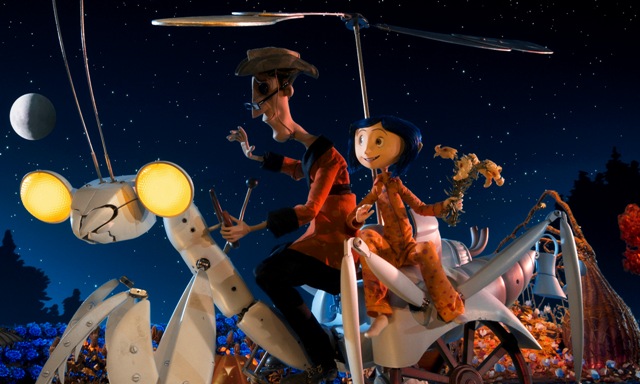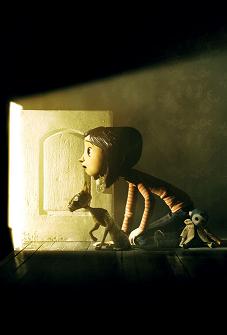What a simple, brilliant story, in any medium1: Coraline Jones, bored and feeling unloved, goes exploring in her new home and finds a small, secret door—and, through the door, a skewed reflection of the house and environs, inhabited by versions of her parents and neighbors who are more fun, more exotic, and much more focused on Coraline than anyone in her life seemed to be before. The only problem is that they all have black buttons in the place of their eyes, and if Coraline wants to stay, they say, she’ll have to sew the buttons in, too. When she decides she doesn’t want to stay well, that’s when Coraline discovers that her Other Mother doesn’t care quite as much about what Coraline wants as she claims she does.
Under Henry Selick’s meticulous direction and with the aid of an excellent cast of voice actors2, Neil Gaiman’s spare, precise novella is transformed into a beautifully intricate stop-motion spectacle that avoids slavish replication of the plot’s details while remaining largely faithful in tone and spirit to the book. Which is a good thing, of course, since Coraline the book felt like a classic from the moment it was released, and it wouldn’t be too much of a stretch to say that the film could become one, too.
Though, perhaps, their claims to classic status would come from different virtues. Gaiman’s novella offers a solid base to build from: the bravery and cleverness of its heroine, its astute understanding of the interconnected fears and desires of childhood, and its pitch-perfect evocation of resonant literary tropes and imagery (a questionably trustworthy feline guide, a secret portal, an inverted world, and Gaiman’s very own contribution to the indelible images of children’s literature, those worrying black buttons). State-of-the-art technology (wonderfully detailed puppetry and, if you see it in “Real3D,” a 3D experience that manages to be absorbing rather than annoying) and exceptional artistry allow Selick to reproduce these strengths while expanding the vision.
Where Gaiman’s sparseness hinted at the wonders in the Other Mother’s world and allowed imagination to fill in the blanks, Selick offers a profusion of marvels to amaze and delight. Accompanied by the enjoyably unsettling soundtrack and utilizing the 3D tech to the utmost, extended set-pieces like the Other Father touring Coraline on a mechanical mantis around his garden as it blooms riotously into a giant likeness of her face, or the elaborately choreographed performance of her alternate-world upstairs neighbor’s Jumping Mouse Circus, are pure sensory joy.

And when the otherworld shifts from turning-on-the-charm to turning-up-the-terror, the effects are up to the challenge of changing the experience from merely off-kilter to full-on threatening. As the miracles turn sour and the masks begin to crumble, Coraline learns the true meaning of the film’s tagline: “be careful what you wish for.”
The movie, perhaps necessarily for mass consumption, slightly conventionalizes the narrative of the novella. Certain changes and additions to the plot strip out some of the subtleties (her parents’ objectively awful behavior at the beginning), and add a hint of moralizing (there’s a suggestion that Coraline is at least partly to blame for her entrapment because she willfully disobeys her mother). Still, even if the movie is not as subversively strange or bone-deep disturbing as the book (which, for its part, remains one of the most intensely uncanny stories I can recall), it certainly creates an effectively creepy atmosphere. And I was quite gratified to see that Coraline had lost none of her smarts, guts, or resourcefulness in translation. Every victory she achieves is well-earned with a quick plan or act of real courage.
So while comparing it too much to the source material may be a sucker’s game (as such comparisons usually are), and a good way to ensure you enjoy it less than you otherwise might, the movie carves out its own worthy niche. Impressively, impeccably crafted all the way through, Coraline seems likely to endure as an exemplary visual experience with a compelling narrative, and any film this exuberantly inventive deserves such longevity. Though perhaps I should be clear—it first deserves to be seen in the theater.
Amusing endnote: the Ziegfeld theater, like all of Coraline’s “real world” neighbors, got her name wrong. According to the Zieg’s ticket, I paid $16.50 (3D is expensive, man) to watch a movie called “Caroline.”
1So far it’s reached three: book, graphic novel, and this film, not counting variations like the audiobook or non-3D cut of the movie.
2Including Dakota Fanning, Teri Hatcher, John Hodgman, Keith David, and the musical stylings of They Might Be Giants.










